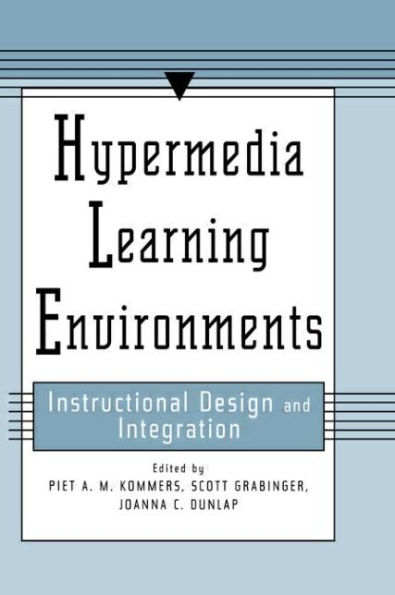Hypermedia and multimedia have penetrated the world of computer games, Internet, and CD-ROM based reference manuals. However, the fields of education, schooling, and training ask more specific benefits from them. This book provides practical approaches to transform these media into learning tools. Crucial helping steps include the migration from expository to exploratory learning strategies, the integration of collaborative learning practices in plenary and individualistic teaching styles, and the evolution from test-driven to experience-oriented training.
This volume has three goals:
* to discuss the concepts of hypermedia, multimedia, and hypertext and review pertinent research lines;
* to provide guidelines and suggestions for developing multimedia applications; and
* to place technology within a broader context of education and training through a discussion of rich environments for active learning (REALs).
The book takes a developmental focus to helpf readers set up and manage the process of developing a multimedia application. It is not a technical or a how-to manual on working with video, sound, digitized graphics, or computer code. The text takes a unique approach to the idea of media— viewing media as delivery systems: if video is called for, use it; if sound will help in an application, use it. The fundamental guidelines presented here are usually not media specific. Media works only within the strategies with which they are used.
Aimed at practitioners—people who teach about or develop multimedia and hypermedia applications—this volume carefully examines the main components and issues in developing applications. It provides suggestions and heuristics for sound, fundamental design processes.
1139546086
This volume has three goals:
* to discuss the concepts of hypermedia, multimedia, and hypertext and review pertinent research lines;
* to provide guidelines and suggestions for developing multimedia applications; and
* to place technology within a broader context of education and training through a discussion of rich environments for active learning (REALs).
The book takes a developmental focus to helpf readers set up and manage the process of developing a multimedia application. It is not a technical or a how-to manual on working with video, sound, digitized graphics, or computer code. The text takes a unique approach to the idea of media— viewing media as delivery systems: if video is called for, use it; if sound will help in an application, use it. The fundamental guidelines presented here are usually not media specific. Media works only within the strategies with which they are used.
Aimed at practitioners—people who teach about or develop multimedia and hypermedia applications—this volume carefully examines the main components and issues in developing applications. It provides suggestions and heuristics for sound, fundamental design processes.
Hypermedia Learning Environments: Instructional Design and Integration
Hypermedia and multimedia have penetrated the world of computer games, Internet, and CD-ROM based reference manuals. However, the fields of education, schooling, and training ask more specific benefits from them. This book provides practical approaches to transform these media into learning tools. Crucial helping steps include the migration from expository to exploratory learning strategies, the integration of collaborative learning practices in plenary and individualistic teaching styles, and the evolution from test-driven to experience-oriented training.
This volume has three goals:
* to discuss the concepts of hypermedia, multimedia, and hypertext and review pertinent research lines;
* to provide guidelines and suggestions for developing multimedia applications; and
* to place technology within a broader context of education and training through a discussion of rich environments for active learning (REALs).
The book takes a developmental focus to helpf readers set up and manage the process of developing a multimedia application. It is not a technical or a how-to manual on working with video, sound, digitized graphics, or computer code. The text takes a unique approach to the idea of media— viewing media as delivery systems: if video is called for, use it; if sound will help in an application, use it. The fundamental guidelines presented here are usually not media specific. Media works only within the strategies with which they are used.
Aimed at practitioners—people who teach about or develop multimedia and hypermedia applications—this volume carefully examines the main components and issues in developing applications. It provides suggestions and heuristics for sound, fundamental design processes.
This volume has three goals:
* to discuss the concepts of hypermedia, multimedia, and hypertext and review pertinent research lines;
* to provide guidelines and suggestions for developing multimedia applications; and
* to place technology within a broader context of education and training through a discussion of rich environments for active learning (REALs).
The book takes a developmental focus to helpf readers set up and manage the process of developing a multimedia application. It is not a technical or a how-to manual on working with video, sound, digitized graphics, or computer code. The text takes a unique approach to the idea of media— viewing media as delivery systems: if video is called for, use it; if sound will help in an application, use it. The fundamental guidelines presented here are usually not media specific. Media works only within the strategies with which they are used.
Aimed at practitioners—people who teach about or develop multimedia and hypermedia applications—this volume carefully examines the main components and issues in developing applications. It provides suggestions and heuristics for sound, fundamental design processes.
29.99
In Stock
5
1

Hypermedia Learning Environments: Instructional Design and Integration
294
Hypermedia Learning Environments: Instructional Design and Integration
294Paperback(New Edition)
$29.99
29.99
In Stock

Product Details
| ISBN-13: | 9780805818291 |
|---|---|
| Publisher: | Taylor & Francis |
| Publication date: | 09/01/1996 |
| Edition description: | New Edition |
| Pages: | 294 |
| Product dimensions: | 7.00(w) x 10.00(h) x (d) |
About the Author
From the B&N Reads Blog
